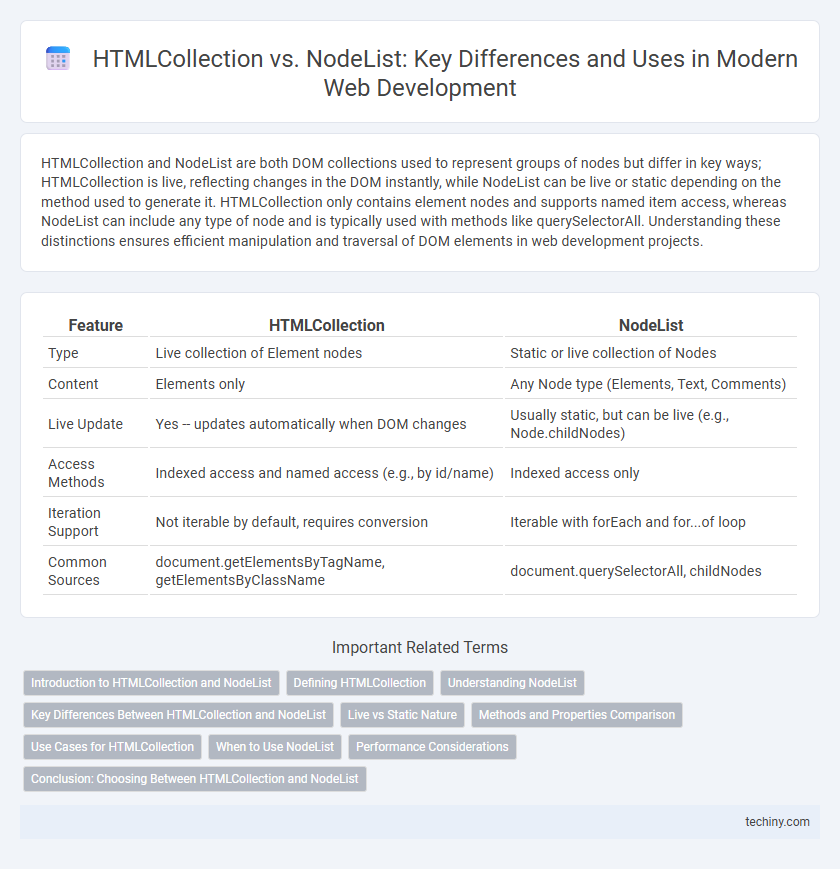HTMLCollection and NodeList are both DOM collections used to represent groups of nodes but differ in key ways; HTMLCollection is live, reflecting changes in the DOM instantly, while NodeList can be live or static depending on the method used to generate it. HTMLCollection only contains element nodes and supports named item access, whereas NodeList can include any type of node and is typically used with methods like querySelectorAll. Understanding these distinctions ensures efficient manipulation and traversal of DOM elements in web development projects.
Table of Comparison
| Feature | HTMLCollection | NodeList |
|---|---|---|
| Type | Live collection of Element nodes | Static or live collection of Nodes |
| Content | Elements only | Any Node type (Elements, Text, Comments) |
| Live Update | Yes -- updates automatically when DOM changes | Usually static, but can be live (e.g., Node.childNodes) |
| Access Methods | Indexed access and named access (e.g., by id/name) | Indexed access only |
| Iteration Support | Not iterable by default, requires conversion | Iterable with forEach and for...of loop |
| Common Sources | document.getElementsByTagName, getElementsByClassName | document.querySelectorAll, childNodes |
Introduction to HTMLCollection and NodeList
HTMLCollection and NodeList are both DOM collections used to represent groups of HTML elements, but they differ in their origin and behavior; HTMLCollection is a live collection of elements typically returned by methods like getElementsByTagName, while NodeList can be live or static and is commonly returned by querySelectorAll. HTMLCollection only contains element nodes, whereas NodeList can include any type of nodes such as text or comment nodes. Understanding the differences between these collections is crucial for efficient DOM manipulation and performance optimization in web development.
Defining HTMLCollection
An HTMLCollection is a live, ordered collection of DOM elements typically retrieved using methods like getElementsByTagName or children property, reflecting real-time changes in the document structure. Unlike NodeList, which may be static depending on the method used (e.g., querySelectorAll returns a static NodeList), HTMLCollection always updates dynamically as the DOM changes. This makes HTMLCollection particularly useful for scripting scenarios where monitoring live changes to the HTML elements is required.
Understanding NodeList
A NodeList is a collection of nodes returned by methods like querySelectorAll(), representing DOM elements that match a specified selector. Unlike HTMLCollection, which only contains element nodes, a NodeList can include any node type such as text or comment nodes. NodeLists can be live or static depending on the method used, where static NodeLists do not update with DOM changes, providing predictable iteration during scripts.
Key Differences Between HTMLCollection and NodeList
HTMLCollection and NodeList are both collections of DOM nodes but differ in key aspects: HTMLCollection is live and updates automatically when the DOM changes, whereas NodeList can be live or static depending on the method used. HTMLCollection only contains element nodes, while NodeList can include any node type, such as text nodes or comment nodes. Access methods also vary; HTMLCollection does not support the forEach() method directly, but NodeList does, enhancing iteration capabilities in modern JavaScript.
Live vs Static Nature
HTMLCollection objects represent live collections of DOM elements, automatically updating as the document structure changes, whereas NodeList objects can be either live or static depending on the method used to retrieve them. Methods like document.getElementsByTagName return live HTMLCollections, reflecting real-time changes, while methods such as querySelectorAll produce static NodeLists that do not update after initial retrieval. Understanding the live versus static nature is crucial for efficient DOM manipulation and avoiding unexpected behavior in dynamic web applications.
Methods and Properties Comparison
HTMLCollection and NodeList are collections used in web development to handle lists of DOM elements, but they differ in supported methods and properties. HTMLCollection is a live collection that supports item() and namedItem() methods and allows access via indexes or element names, while NodeList can be either live or static, supports forEach(), and provides access through item() and indexing. For modern JavaScript manipulation, NodeList is preferred due to its compatibility with array methods like forEach(), whereas HTMLCollection remains useful for accessing elements by their names or IDs.
Use Cases for HTMLCollection
HTMLCollection is best suited for scenarios requiring live collections that automatically update as the DOM changes, such as dynamically monitoring form elements or frequently adjusted sections like navigation menus. Its use is ideal when real-time reflection of the document structure is critical, ensuring elements can be accessed by name or index directly. This live nature contrasts with static NodeLists, making HTMLCollection preferable for interactive web applications needing immediate element availability.
When to Use NodeList
NodeList is ideal when working with methods like querySelectorAll that return a static list of nodes, ensuring the collection does not change as the DOM updates. It supports iteration with forEach, making it convenient for modern JavaScript loops and array-like manipulation. Use NodeList when you need a snapshot of elements at a specific moment without live tracking of DOM changes.
Performance Considerations
HTMLCollection and NodeList differ in performance, with HTMLCollection being live and dynamically updating as the DOM changes, potentially causing slower access times in frequently modified document structures. NodeList, often static when obtained via querySelectorAll, provides faster access for iteration and manipulation due to its fixed snapshot nature. Choosing between them depends on the specific use case, where static NodeLists typically offer better performance for read-heavy operations while live HTMLCollections are beneficial for real-time DOM tracking.
Conclusion: Choosing Between HTMLCollection and NodeList
HTMLCollection provides a live collection that reflects changes in the DOM dynamically, making it ideal for applications requiring real-time updates. NodeList can be either live or static, with methods like forEach available, offering more flexibility for static snapshots of DOM elements. Choose HTMLCollection for performance in live collections and NodeList for ease of iteration and static data manipulation.
HTMLCollection vs NodeList Infographic

 techiny.com
techiny.com